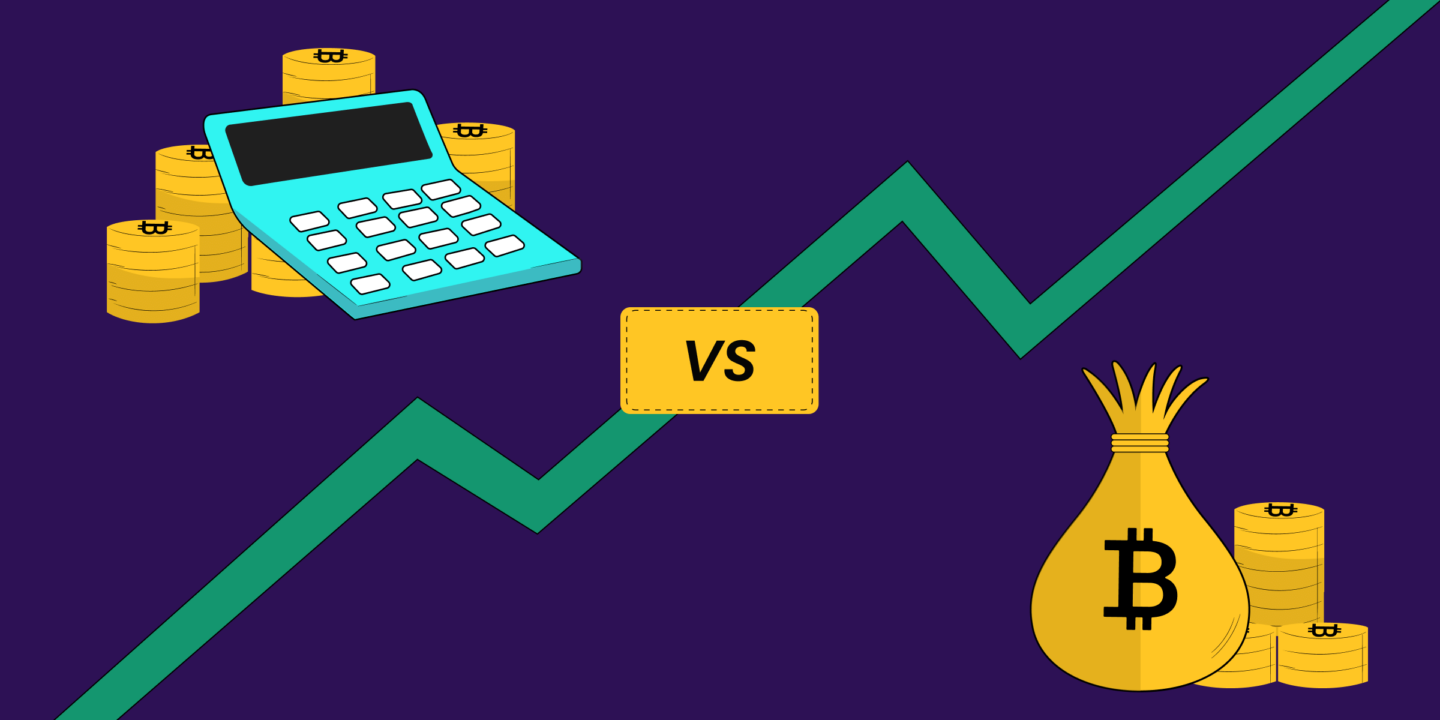
If we ask you why you invest your money in cryptos, the answer would be obvious – to earn better returns, correct? Cryptocurrencies in the past have provided superior returns over other financial instruments, including stocks, while also yielding the benefit of diversification. At the same time, it offers opportunities like lending and borrowing to earn additional returns. APR and APY being the measures to calculate returns for the same.
APR or Annual Percentage Rates, in simple terms, refers to the interest you earn for lending your money or the interest you pay if you are the one borrowing. Take an example of the interest on your credit card. The definition of APY or Annual Percentage Yield is also the same but just add compounding to it.
While on the subject of returns, grab the chance to earn 10% on your cryptos with the Mudrex Vault!
What Is APR (Annual Percentage Rate) in Crypto?
Have you heard about crypto lending? It refers to a crypto holder lending owned cryptos to a borrower. This results in interest earnings on the given crypto loan. This is directly associated with what APR is in cryptocurrency. The interest income you can expect as an investor for lending your cryptos to borrowers is the Annual Percentage Rate for you. If you have borrowed cryptos, it is the interest amount you will pay.
Depending on the type of crypto, volatility, and prevailing rates, your APR is likely to be decided and may change given market conditions. APR also includes any fees a borrower may require to pay however it does not account for compound interests.
Example of APR
Understanding APR in cryptocurrency is quite simple. Let’s say your crypto platform allows you to stake 1 Bitcoin at a 25% interest rate per annum. This means you will earn 0.25 Bitcoin for loaning your 1 Bitcoin. However, for this, you have to lend Bitcoin for an entire year.
At the end of the investment period, the Bitcoin number you own would be 1.25. 1 is your principal Bitcoin, and 0.25 is Bitcoin earned in interest.
This is how APR calculations are done. Now let’s actually calculate it.
How to calculate APR?
APR is calculated on the principal amount and gets affected by the predicted interest rate.
Annual Percentage Rate = [P x (1 + R x T) ]
Whereas,
P = Principal loan amount
R = Rate of interest
T = Time period in years
Let’s put some numbers in this formula for a scenario where you loan 3 Ether at 23% interest rate for a year.
APR = [3 Ether x (1 + (23% x 1) ]
= [3 x 1.23]
= 3.69 Ether
At the end of the investment period, you will have 0.69 Ether in interest. However, one thing you should note here is that since the investment period is 1 year, if you decide to withdraw the Ether before that, your interest income will reduce. For example, for 6 months, the interest would reduce from 23% to 11.5%, and you will only earn 0.345 Ether.
What Is APY (Annual Percentage Yield) in Crypto?
APY refers to the amount of interest you can earn by lending your cryptos, just like APR. However, APY takes it a notch higher and adds compound interest for the investment period.
Compound interest refers to the interest you earn on your principal investment and the returns on your investment. This means with APY, you earn more income compared to APR.
Example of APY
In the example of APR, we considered that you loaned 1 Bitcoin at a 25% rate for a year. In this example, let’s consider you lent the same number of Bitcoins for 1 year with the compounding frequency being 6 months. So, the total interest you will receive at the end of the year will reflect the accumulated interest.
Your Bitcoin, every 6 months, will start including the earned interest. Given this, after a year, the total Bitcoin you will have will be 1.27. It is higher by 0.02 compared to APR.
How to calculate APY: Formula
Let’s see how you can calculate APY in cryptos.
Annual Percentage Yield = (1 + r / n) n – 1
Whereas,
r = Rate of interest
n = the total number of compounding periods
Let’s take the same example we took earlier of Ether to calculate APY. Assuming the compounding period is quarterly and the interest rate is 23%.
APY = (3 + 0.23 / 4) 4 – 1
= 3.75 Ether
With APY, you are likely to earn 0.06 more Ether.
Note that the frequency of interest compounding can be anything for APY – daily, weekly, monthly, quarterly, bi-annually, and annually. Based on the frequency period, your interest income will change.
APR Vs. APY: The Major Differences
Now that our base is clear for what is APR and APY in crypto, let’s see what elements create differentiation in both.
| APR | APY |
| Annual Percentage Rate refers to the interest income earned for a year for lending cryptos. However, it considers only the principal amount for interest calculation. | Annual Percentage Yield is similar to APR in meaning but different when calculating the interest income as it also accounts for accumulated interest, offering you the benefits of compounding. |
| APR interest income is lower compared to APY. | Because APY accounts for principal + interest income for calculating the total compounding return, it typically yields more income. |
| If you are on the other side of the road and are borrowing cryptos, choosing APR will be beneficial for you as you pay less interest. | On the other hand, APY is more beneficial to lenders as it accounts for compounding interest. |
| Many DeFi platforms and cryptos opt for APR, and it is easy to calculate. | Given the broader use of APR, you may have to manually calculate APY, which can be a little difficult. However, you can always use compounding calculators to calculate the rate of interest. |
If you are looking to lend your cryptos or want to borrow one, you need to know the difference between APR and APY, as that will have a significant impact on your cash. Many crypto platforms and exchanges would provide you with the facility to lend/borrow cryptos. However, do your research on terms and conditions, associated fees, and interest calculator frequency before concluding a decision.
Which Is Better, APR or APY?
Now comes the question from APR vs. APY, which one is better, and which one should you use? Both APR and APY calculator interest income; however, the latter also includes accumulated interest for calculation and thus yields a higher sum.
Thus, if you are a lender or an investor, using APY is more beneficial for you. However, if you are a borrower, APR is more beneficial since you will pay less interest.
Conclusion
Before lending or borrowing, it is always important to analyze the interest you will earn or pay. APR and APY are two such tools that help you calculate the interest income on your crypto investments.
FAQs
1. Are APR and APY the same thing?
No, APR and APY are two different methods to calculate interest rates on lending or borrowing. APR means Annual Percentage Rate, it calculates the interest income you will pay/receive on your borrowed/lent money. On the other hand, APY, or Annual Percentage Yield, accounts for interest income earned on the invested amount. Like a savings account, APY is calculated using compounding interest.
2. Why do banks use APY instead of APR?
Banks typically pay compounding interest on their various instruments, including savings accounts and fixed deposits. Thus, using APY is more relevant to banks since it also accounts for the accumulated interest in calculations, unlike APR.
3. Why is APY higher than APR?
The Annual Percentage Yield is calculated by adding the earned interest to the principal amount. It increases the base amount to calculate the interest for the next calculation period and thus offers a higher interest rate.
4. Is APY paid monthly?
If the frequency for the compounding period is set monthly, the interest you earn would be on a monthly basis. However, depending on the chosen method, whether to reinvest the interest or withdraw it, you may or may not get the same in hand.
5. What does 5.00% APY mean?
A 5.00% Annual Percentage Yield means you will receive a 5.00% interest income on your investments annually. Based on the frequency of compounding, you will earn interest income on your principal plus the accumulated interest for the entire investment tenure. For example, if you have invested Rs. 100 for 2 years with a 5.00% APY compounded yearly, you will receive Rs. 110.25 at the end of the second year.





